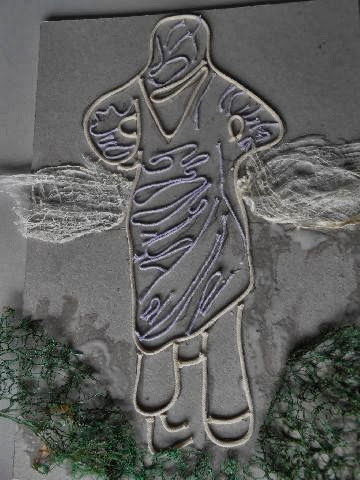Today I would like to sum up the three fundamental factors of the colour: value, hue and saturation and give you some exercises – if you feel like doing them.
We saw that all these three factors can liven up or subdue the composition. There are no real “rules” how to use them and as I said, many of us use them intuitively. Knowledge can help us to correct not-quite-right-intuitions as well.
For example: I would like to make a picture/quilt/composition with the theme summer heat. If this is an abstract composition the more important it is to suggest the right sensations. I won’t go now into the other principal elements of the design like line, mark etc. but concentrate on choosing my colours right.
So summer heat: a landscape, nothing dramatic about it. My first intuition: no big value differences, keeping it calm and quiet. Hues: mostly warm colours, referring the heat. So I’ve chosen two factors with reduced scales – but I don’t want my composition to be boring. I would like to bring some life into it with the last colour-factor what is left: saturation: I can choose mostly warm hues, little to medium value-differences and pay attention that I use glowing and dull colours enhancing the inherent light and make the picture lively. The beginning could be to collect my colours: make a grid, colour it with paint, pastel, or use your computer or cut small fabric pieces and glue them on. This is generally a good exercise you can repeat with different themes what could be easily associated with colour sensations, like heat, cold, the seasons, water, rain forest etc.
I would like to show some results, how artist had handled this:
Paul Klee’s Castle and Sun is painted mostly in warm colours with reduced value-difference in it. The yellows are light, yes but they take up little surface compared to the reds and browns.
Just to control the values, here is the black and white version:
Back to the original: as said, the yellows bring in some value-difference, but they are a bit too cool colours! What really carry the heat are the pure, intense, glowing reds! Remember, I said last time that when working with saturation-difference, the effect shall appear stronger when the colours are closer in value. And this is what works so beautifully here with the reds, oranges and browns.
Almost the same could be said regarding Claude Monet’s Vetheuil in the Summer and Van Gogh’s Wheat Field with Reaper and Sun. In both picture you find so many yellows of different saturation making them lively - not overly dramatic but in noways flat either.I'll skip longer explanation, just regard them and try to explain it to yourself.
In contrast to those two, here is Edward Hopper’s Nighthawks. This is a painting what shows a summer night scene but the emphasis is not on the heat - thought one can sense it lightly - but on the scene itself. It is so full of tension. Hopper conveys a mood of loneliness. But of this picture Hopper said: `I didn't see it as particularly lonely... Unconsciously, probably, I was painting the loneliness of a large city.' He reaches this dramatic tension using big value differences. The hues are subdued and the saturation doesn’t play a central role either.
If you have any question to hue, value and saturation, feel free to ask, I’ll try to answer them.
And now, the exercise(s):
1.
Make a simple, maybe geometrical design. (A tip: a simple drawing programm on your computer will help.) Try to keep it simple. You can also use one of your favourite abstract paintings, maybe something from Paul Klee or just use a geometrical grid of squares and rectangles or concentrical circles (like the painting of Kandinsky).
Prepare three variations from the same design:
- one concentrating on values – use big value differences. Try to create a strong, dynamic composition. Convert the result into black and white, to control it.
- The second colour study should be about hue and temperature. Try to create spatial sensation, a “movement” in your composition.
- The third example should be about saturation. Use a variety of glowing and dull colours to generate a lively, dynamic sensation.
When ready, look at you results and think about it what works for you. All three? Wonderful! You don’t feel very comfortable working with saturation, for example? Leave it or better go on experimenting with it and you’ll get better. Your three compositions will probably all be very different though you’ve used the same forms. Colour is a mighty design factor.
And something fun: convert copies of paintings you like into new colour compositions. Use the same image but change the colour concept. This can be real fun. Important: take time to think over your results: what does work and what doesn’t? Could you bring up new sensations just by changing colours?
2.
More practical could be to collect your fabrics, cut off little squares of 1 x 1 inch and arrange different colour ranges with them:
- broad hue, value and saturation range within one sample
- narrow hue range, broad value range and moderate saturation range
- narrow hue, value and saturation range
- narrow hue and value range, broad saturation range
When done, note some adjectives you would use to describe the colour sensations these ranges evoke and try to think about in what context you could use these colour groups.
I’ll make a short break here and let you work. If you do the exercises and send me the results – beatakeller@yahoo.com - I would love to show them here. In a few days I’ll continue discussing contrasts.




















































